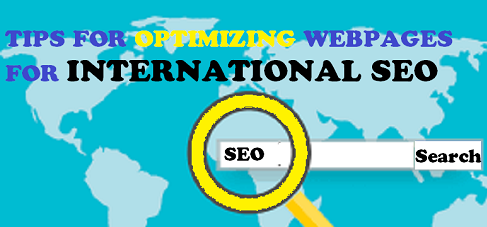International SEO Optimization
International SEO is the way you tell Google search engine and other search engines, that you want to target specific countries and using different languages to conduct business and brands. For this reason, you have to make strategies for international SEO and cover every aspect from how to handle your URL structure to using hreflang tags, target location, language, target audience.

International SEO is a practice of optimizing websites according to which countries you want to target for SEO purposes so that search engines can easily identify the countries you want to target and which languages you use for business and brand.
Check your on-page ranking factor for SEO ranking, which helps in optimizing webpages.
1. Country Targeting: Specify the target country and/or region with an international-friendly URL structure.
2. Language Targeting: Establish which language your pages are targeting with the use of language tags.
3. Target Users: Create and maintain content in your target users' language(s). These are the raw materials with which you will actually you want to rank on keyword and leads goal and conversion.
4. Keyword Targeting: Search the keyword international business, actually you want to do SEO with ranking.
International SEO best practices
International SEO practices are also known as Global SEO Strategy.
1. URL Structures for International Sites:
If you planning for international SEO, first of all, optimize your URL structure for international SEO.
You must use a:
1. Country Code Top-level Domain (ccTLD)
2. Subdomain
3. Subdirectory or subfolder
4. gTLD with language parameters
5. Using a different domain name entirely
1. ccTLD
example.us - ccTLD
2. Subdomain
the subdomain is a domain that is a part of the main domain. Subdomains give more state of affairs or effect as to the content and location of pages on your site. Internationalized content should is placed on a separate subdomain.
us.example.com - subdomain
3. Subdirectory
Internationalized content for your webpages is placed in a specific subdirectory or subfolder, of a root domain. the subdirectory is a pathway within your site.
example.com/us- subdirectory
4. gTLD with language parameters
example.com/?lang=en-us - gTLD with language parameters
5. Different domain
exampleussite.com- different domain
6. Language-target your website And website pages

If you have an online clothing company/business that specialized in shirts as in language/slogan in Spanish. In this case, Mexico is the same relevant as Spain for your business, you should target the Spanish language, but not any specific country. Because the Spanish language is spoken in multiple countries.
Example:
1.
Sample URL - spanishgency.es
Search engine target interpretation – all searchers in Spain
Internationalization “type” - country
URL structure type - ccTLD
2.
Sample URL - ca.italianagency.es and hreflang=ca tag
Search engine target interpretation - Catalan speaking searcher in Spain
Internationalization “type” - country and language
URL structure type - ccTLD +subdomain
3.
Sample URL - ca.spanishagency.com and hreflang=ca tag
Search engine target interpretation - Catalan-speaking searchers worldwide
internationalization “type” - language
URL structure type - subdomain
4.
Sample URL - spanishagency.es/?lang=ca hreflang
Search engine target interpretation - Catalan speaking searchers in Spain
Internationalization “type” - country and language
URL structure type - ccTLD+language parameters
5.
Sample URL - spanishagency.com/?lang=ca hreflang
Search engine target interpretation - Catalan speaking searcher in worldwide
Internationalization “type” - language
URL structure type - gTLD+language parameters
6.
Search engine target interpretation - searchers in france
Internationalization “type” - country
URL structure type - ccTLD
Use Hreflang Tags for Language Targeting
Hreflang tags are of code used on websites with content in multiple languages. it helps search engines match up the correct language with the searcher.
for example: Spanish speakers will see your Spanish content instead of your English.
Hreflang Tags Example
Each tag specifies the country and language of users and is placed after the URL.
you should knowledge about that “en-US” means for english speakers in the united states, and "ar-AE” is for Arabic speakers in the united arab emirates,
and if have “en-AE” is for english speakers in the united arab emirates.
2. In the HTTP header on every page
3. In your Sitemap
you should also have the knowledge, Google doesn’t penalize for duplicate content, especially when it is in a different language. You must tell Google which version to show for each country/language. You would use hreflang for that.
7. How To Measure Global Traffic?
